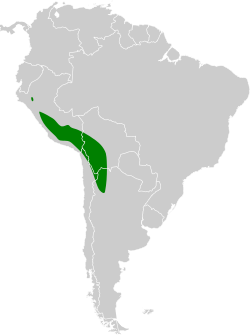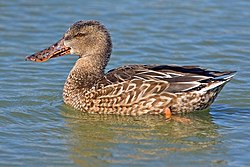| Common name | Scientific name and subspecies | Range | Size and ecology | IUCN status and estimated population |
|---|
| Garganey 
Male

Female | Spatula querquedula
(Linnaeus, 1758) | Europe and Asia, also in Africa in winter
 | Size: 37–41 cm
Habitat:
Diet: | LC
|
|---|
| Blue-billed teal  | Spatula hottentota
(Eyton, 1838) | eastern and southern Africa, from Sudan and Ethiopia west to Niger and Nigeria and south to South Africa and Namibia | Size: 30–36 cm
Habitat:
Diet: | LC
|
|---|
| Puna teal  | Spatula puna
(Tschudi, 1844) | the Andes of Peru, western Bolivia, northern Chile and extreme northwestern Argentina
 | Size: 48–51 cm
Habitat:
Diet: | LC
|
|---|
| Silver teal  | Spatula versicolor
(Vieillot, 1816)
- S. v. versicolor(Vieillot, 1816)
- S. v. fretensis(King, 1831))
| southern Bolivia, southern Brazil, Paraguay, Argentina, Chile, Uruguay, South Georgia, the South Sandwich Islands and the Falkland Islands
 | Size: 38–43 cm
Habitat:
Diet: | LC
|
|---|
| Red shoveler 
Male

Female | Spatula platalea
(Vieillot, 1816) | Tierra del Fuego northwards to Chile and most parts of Argentina, as well as the Falkland Islands and small isolated breeding populations in southern Peru
 | Size: 45–56 cm
Habitat:
Diet: | LC
|
|---|
| Cinnamon teal 
Male

Female | Spatula cyanoptera
(Vieillot, 1816)
- Spatula cyanoptera septentrionalium (Oberholser, 1906)
- Spatula cyanoptera tropica (Snyder & Lumsden, 1951)
- Spatula cyanoptera borreroi (Snyder & Lumsden, 1951)
- Spatula cyanoptera orinoma (Snyder & Lumsden, 1951)
- Spatula cyanoptera cyanoptera (Vieillot, 1816)
| South America, western United States and extreme southwestern Canada; a rare visitor to the East Coast of the United States
 | Size: 35–48 cm
Habitat:
Diet: | LC
|
|---|
| Blue-winged teal 
Male

Female | Spatula discors
(Linnaeus, 1766) | North America, where it breeds from southern Alaska to Nova Scotia and south to northern Texas, wintering south to northern South America
 | Size: 35–41 cm
Habitat:
Diet: | LC
|
|---|
| Cape shoveler 
Male

Female | Spatula smithii
Hartert, 1891 | South Africa, uncommon further north in Namibia, Botswana, Zimbabwe, southern Angola, Lesotho, Mozambique and Zambia | Size: 51–53 cm
Habitat:
Diet: | LC
|
|---|
| Australasian shoveler 
Male

Female | Spatula rhynchotis
(Latham, 1801)
- S. r. rhynchotis(Latham, 1801)
- S. r. variegata(Gould, 1856)
| Australia, Tasmania and New Zealand | Size: 46–56 cm
Habitat:
Diet: | LC
|
|---|
| Northern shoveler 
Male

Female | Spatula clypeata
(Linnaeus, 1758) | Northern areas of Europe and Asia and across most of North America, wintering south to northern Africa, southern Asia and northernmost South America
 | Size: 43–56 cm
Habitat:
Diet: | LC
|
|---|


























